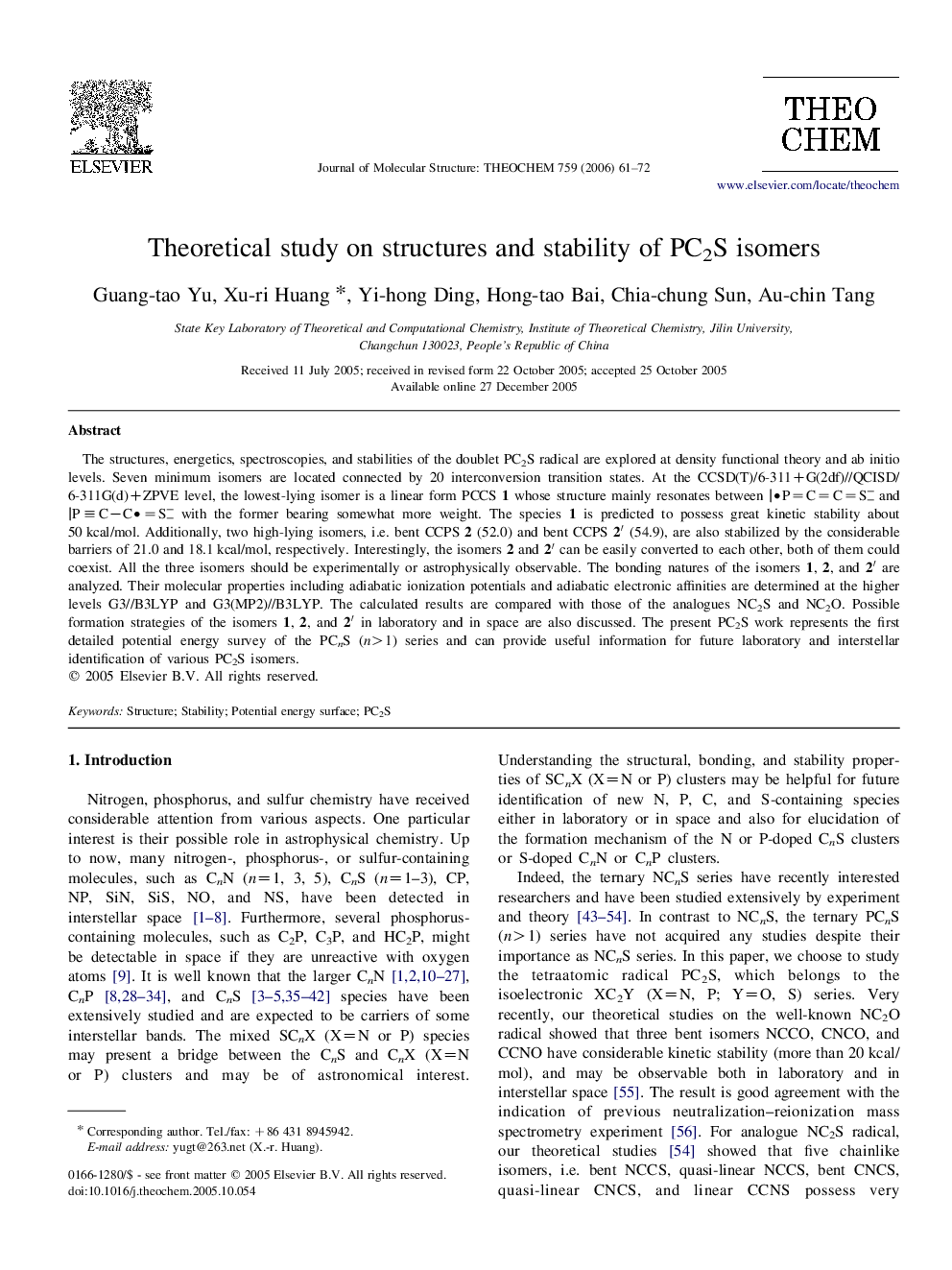| Article ID | Journal | Published Year | Pages | File Type |
|---|---|---|---|---|
| 5419174 | Journal of Molecular Structure: THEOCHEM | 2006 | 12 Pages |
Abstract
The structures, energetics, spectroscopies, and stabilities of the doublet PC2S radical are explored at density functional theory and ab initio levels. Seven minimum isomers are located connected by 20 interconversion transition states. At the CCSD(T)/6-311+G(2df)//QCISD/6-311G(d)+ZPVE level, the lowest-lying isomer is a linear form PCCS 1 whose structure mainly resonates between |
- P=C=C=Sââ and |Pâ¡CâC
- =Sââ with the former bearing somewhat more weight. The species 1 is predicted to possess great kinetic stability about 50Â kcal/mol. Additionally, two high-lying isomers, i.e. bent CCPS 2 (52.0) and bent CCPS 2â² (54.9), are also stabilized by the considerable barriers of 21.0 and 18.1Â kcal/mol, respectively. Interestingly, the isomers 2 and 2â² can be easily converted to each other, both of them could coexist. All the three isomers should be experimentally or astrophysically observable. The bonding natures of the isomers 1, 2, and 2â² are analyzed. Their molecular properties including adiabatic ionization potentials and adiabatic electronic affinities are determined at the higher levels G3//B3LYP and G3(MP2)//B3LYP. The calculated results are compared with those of the analogues NC2S and NC2O. Possible formation strategies of the isomers 1, 2, and 2â² in laboratory and in space are also discussed. The present PC2S work represents the first detailed potential energy survey of the PCnS (n>1) series and can provide useful information for future laboratory and interstellar identification of various PC2S isomers.
- P=C=C=Sââ and |Pâ¡CâC
- =Sââ with the former bearing somewhat more weight. The species 1 is predicted to possess great kinetic stability about 50Â kcal/mol. Additionally, two high-lying isomers, i.e. bent CCPS 2 (52.0) and bent CCPS 2â² (54.9), are also stabilized by the considerable barriers of 21.0 and 18.1Â kcal/mol, respectively. Interestingly, the isomers 2 and 2â² can be easily converted to each other, both of them could coexist. All the three isomers should be experimentally or astrophysically observable. The bonding natures of the isomers 1, 2, and 2â² are analyzed. Their molecular properties including adiabatic ionization potentials and adiabatic electronic affinities are determined at the higher levels G3//B3LYP and G3(MP2)//B3LYP. The calculated results are compared with those of the analogues NC2S and NC2O. Possible formation strategies of the isomers 1, 2, and 2â² in laboratory and in space are also discussed. The present PC2S work represents the first detailed potential energy survey of the PCnS (n>1) series and can provide useful information for future laboratory and interstellar identification of various PC2S isomers.
Related Topics
Physical Sciences and Engineering
Chemistry
Physical and Theoretical Chemistry
Authors
Guang-tao Yu, Xu-ri Huang, Yi-hong Ding, Hong-tao Bai, Chia-chung Sun, Au-chin Tang,
